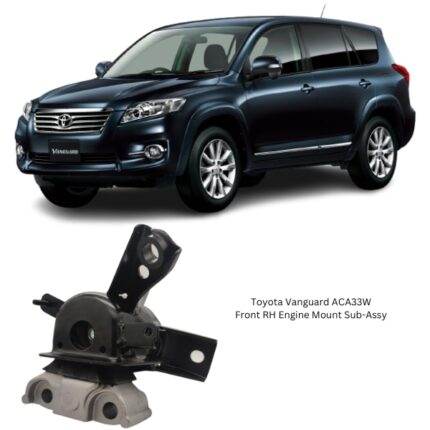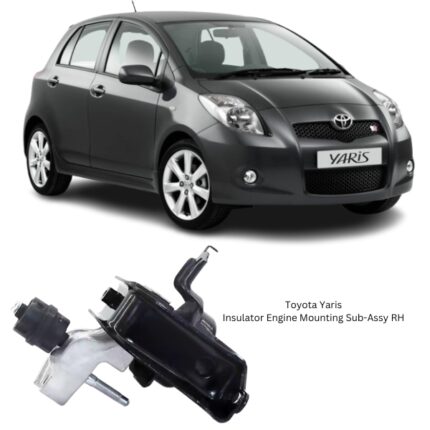Get Toyota Yaris Insulator Engine Mounting Sub-Assy RH 12305-21020 in Kenya
The Insulator Engine Mounting Sub-Assembly RH—commonly referred to as the Right-Hand Engine Mount Insulator Sub-Assy—is a critical structural component designed to support the engine while simultaneously dampening vibrations and noise. Located on the right-hand side of the engine bay, it serves as one of several mounts that work together to secure the engine and transmission assembly to the vehicle chassis, ensuring balanced load distribution, motion control, and powertrain alignment.
As internal combustion engines generate constant motion, noise, and torque reactions, mounts like the RH insulator are engineered to absorb these effects. This mount protects vehicle integrity, driver comfort, and the operational lifespan of nearby components by preventing unwanted movement and vibration transfer from the engine to the body frame.
Primary Role and Functionality
The RH Insulator Engine Mounting Sub-Assy performs several essential roles:
-
Load Bearing Support
It holds a portion of the engine’s static weight while resisting dynamic engine forces during operation. Positioned on the right side, this mount commonly balances loads from the transmission bell housing or the engine block, depending on the powertrain layout. -
Vibration Isolation
One of its core purposes is to isolate vibrations and engine oscillations from the cabin and chassis. This improves ride quality by reducing noise, vibration, and harshness (NVH). -
Motion Control
During rapid acceleration, braking, and gear shifting, the engine can shift in response to torque. The RH insulator mount absorbs this motion, ensuring the engine remains properly aligned. -
Drivetrain Alignment
It helps maintain the correct geometry of the engine and transmission relative to the driveline, improving efficiency and minimizing wear on connected components. -
System Longevity
By limiting engine movement, the mount reduces strain on exhaust pipes, cooling lines, wiring harnesses, and other systems connected to the engine.
Together, these functions contribute to the engine’s stability and the vehicle’s overall mechanical reliability and comfort.
Design and Construction
The Insulator Engine Mounting Sub-Assy RH is built from a combination of metal and elastomeric materials, engineered for strength, flexibility, and environmental resistance.
Key Components:
-
Outer Metal Bracket / Housing
Fabricated from forged steel, cast iron, or aluminum, the outer bracket connects to the chassis or subframe. It provides the structure needed to support both vertical and horizontal loads. -
Rubber or Elastomeric Core
Molded rubber or synthetic elastomer is bonded between the metal housings. This rubber component absorbs vibrations and provides cushioning for the engine. -
Central Sleeve or Bushing
A metal sleeve runs through the center of the insulator, typically used to mount the engine mount bolt. It allows for secure but slightly flexible connection to the engine block or transmission casing. -
Hydraulic Chamber (in advanced models)
Some versions feature a fluid-filled chamber for better low-frequency vibration damping, especially noticeable at idle. -
Protective Coating
The metal components are often treated with zinc plating, powder coating, or other corrosion-resistant finishes to withstand moisture, salt, and engine fluid exposure. -
Heat Shield or Heat-Resistant Materials
In applications near the exhaust manifold or turbocharger, the mount may include a thermal barrier or heat-resistant rubber to prolong service life.
This robust, multi-material design ensures the mount performs effectively under demanding conditions such as high engine heat, chemical exposure, and dynamic driving stresses.
Performance Characteristics
A well-designed RH engine mount insulator delivers a blend of mechanical support and dynamic dampening, allowing it to perform under a wide variety of operational and environmental conditions.
Core Performance Metrics:
-
Load Capacity: Can support both static and dynamic forces from engine weight and movement.
-
Torsional Resistance: Controls engine twist from torque loads, especially during acceleration.
-
Vibration Filtering: Blocks vibrations across a broad frequency range, including low-frequency idle vibrations and high-frequency road impacts.
-
Fatigue Resistance: Designed to endure millions of stress cycles without deforming or cracking.
-
Thermal Tolerance: Performs reliably in engine bays that may exceed 100°C.
-
Chemical Durability: Resistant to oil, coolant, transmission fluid, and road contaminants.
These properties allow the mount to maintain engine stability, cabin comfort, and component alignment throughout its lifespan.
Signs of Wear or Failure
Over time, the Insulator Engine Mounting Sub-Assy RH may degrade due to heat, aging rubber, fluid exposure, or constant dynamic stress. Common signs of failure include:
-
Excessive Engine Vibration
The most noticeable symptom is vibration felt in the steering wheel, floorboards, or cabin, especially at idle. -
Engine Movement
A worn mount may allow the engine to rock excessively when revving or shifting gears. -
Clunking or Impact Noises
When accelerating, braking, or turning, the engine may hit against surrounding components, causing knocking sounds. -
Rubber Deterioration
Visible cracks, splits, or deformation in the rubber section of the mount suggest imminent failure. -
Hydraulic Fluid Leak
If equipped with a hydraulic chamber, leaking fluid indicates internal rupture and loss of damping capability. -
Misalignment Symptoms
Unusual wear on belts or hoses, or misalignment of the exhaust system, may result from a sagging engine due to a failed mount.
Early diagnosis and replacement can prevent additional damage to adjacent systems.
Installation Overview
Installing the RH Insulator Engine Mounting Sub-Assy involves moderate mechanical expertise and should follow proper safety protocols.
Basic Installation Steps:
-
Vehicle Preparation
Ensure the vehicle is on level ground. Disconnect the battery and allow the engine to cool. -
Support the Engine
Use a hydraulic jack with a wood block or an engine hoist to support the engine before unbolting the existing mount. -
Remove Old Mount
Unbolt the mount from both the engine and chassis. Inspect the mounting area and other nearby mounts for wear or damage. -
Install New Mount
Position the new mount correctly, insert mounting bolts, and torque them according to manufacturer specifications. -
Inspect and Test
Start the engine and check for abnormal engine movement, vibration, or noise. A short road test may be necessary to confirm performance.
Correct installation is crucial to restoring proper engine alignment and vibration control.
Maintenance and Inspection Tips
Although engine mounts are generally maintenance-free, regular visual inspection during routine vehicle service can identify early signs of wear.
What to check:
-
Cracks or deterioration in the rubber
-
Mounting bolt tightness
-
Oil or coolant contamination on the mount
-
Engine position or alignment issues
Inspecting all engine mounts as a set is also recommended, as failure of one often puts stress on the others.
Benefits of Replacing a Worn RH Mount
-
Restores Engine Alignment
Keeps the engine centered and balanced, improving performance. -
Reduces Noise and Vibration
Restores cabin comfort and eliminates harshness during operation. -
Protects Other Components
Prevents strain on nearby parts like the exhaust, radiator hoses, and transmission linkage. -
Improves Drivability
Results in smoother gear transitions and engine response. -
Enhances Safety
Minimizes engine shift during sudden stops or turns, reducing the risk of component collision.
Follow us on Facebook for more parts.





Reviews
Clear filtersThere are no reviews yet.